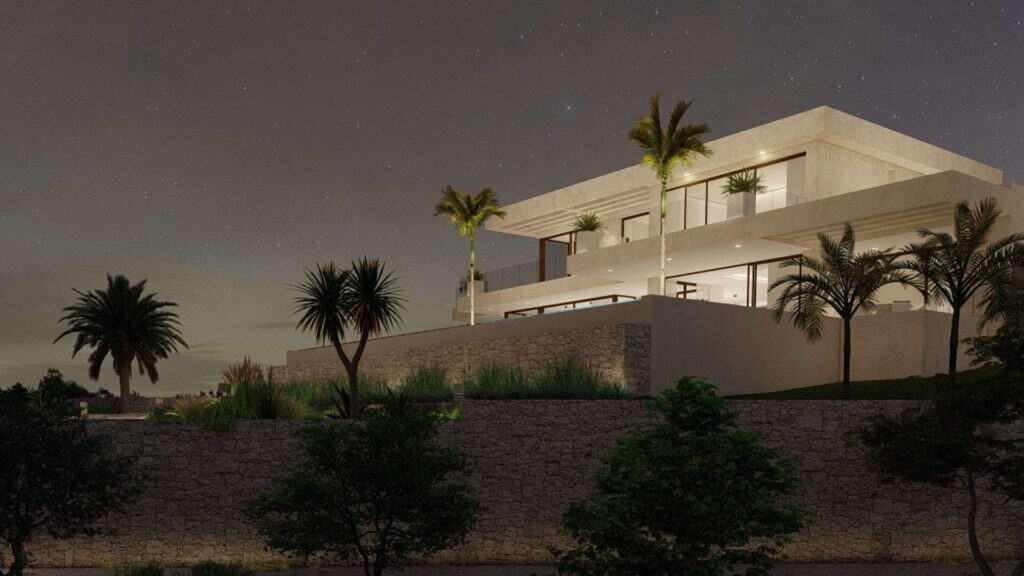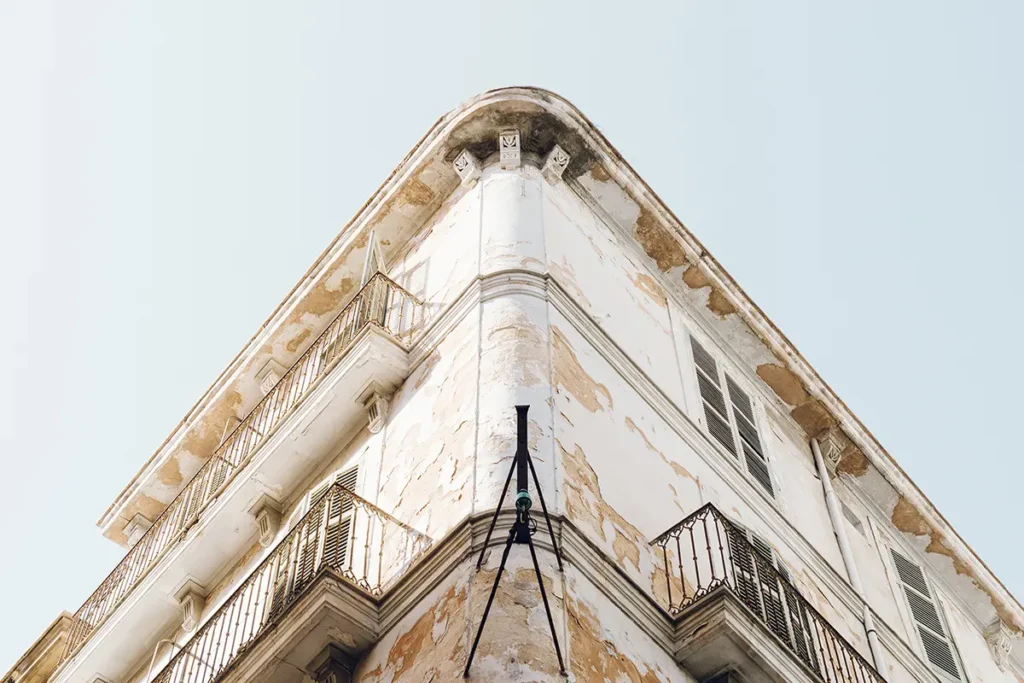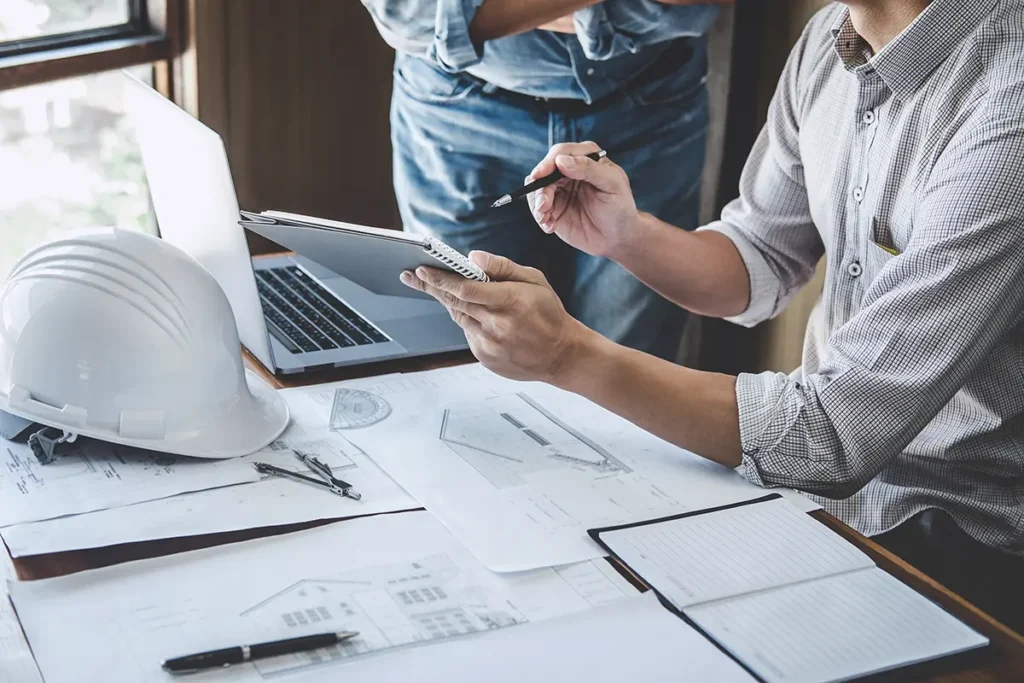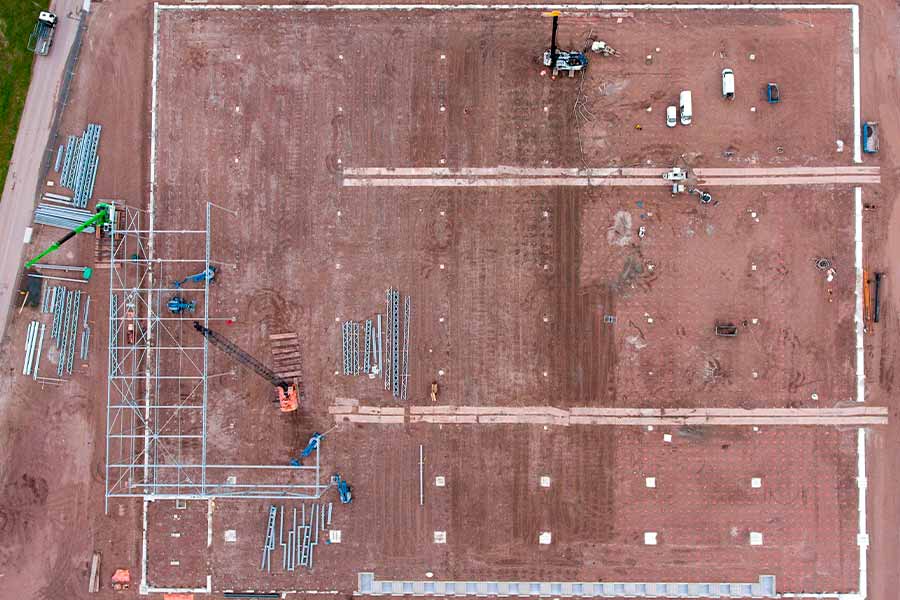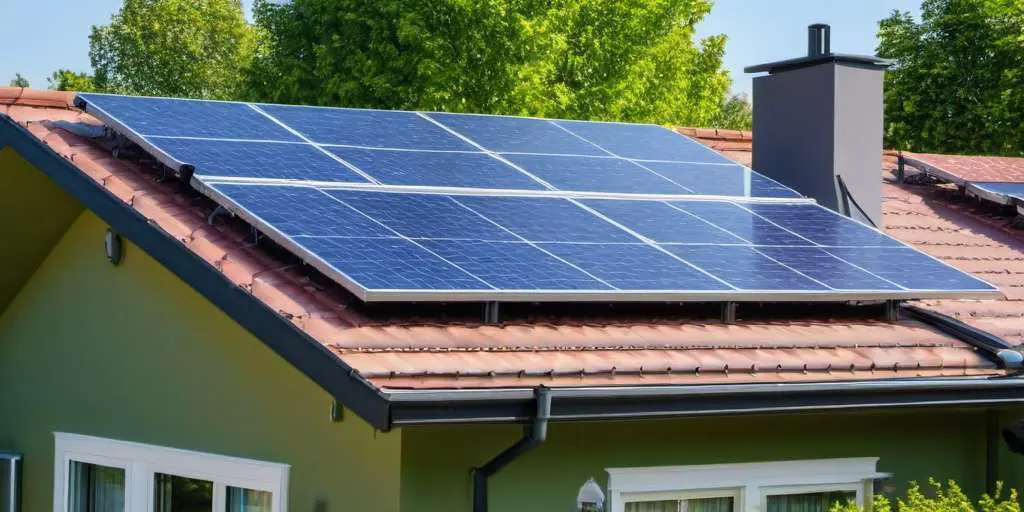Building a villa in Jávea is an attractive option for those looking to enjoy a privileged lifestyle on the Costa Blanca. This municipality combines an impressive natural environment with all the necessary comforts for a comfortable life. The design and construction process requires meticulous planning. It is essential to have an experienced architect, such as La Quinta Fachada, who can guide each phase of the project, ensuring that the villa meets all desired requirements.
Why build a villa in Jávea?
Building a villa in Jávea offers numerous advantages. The combination of its environment, climate, and quality of life make it an ideal destination.
Climate and natural surroundings
Jávea is characterised by a warm Mediterranean climate, with over 300 days of sunshine per year. This environment promotes outdoor activities and guarantees a pleasant atmosphere throughout the year. Its landscapes are exceptionally beautiful, featuring mountains, cliffs, and crystal-clear beaches.
Infrastructure and services
The town offers excellent infrastructure that facilitates daily life. It includes:
- Access to main roads and connections with other cities.
- Quality medical services and well-regarded educational centres.
- A wide range of shops, restaurants, and cultural activities.
Lifestyle in Jávea
Living in Jávea allows you to enjoy a tranquil and healthy lifestyle. Residents can take advantage of the available activities, such as:
- Water sports on the beach.
- Hiking in the mountains.
- Local events and festivals that foster community spirit.
This lifestyle, surrounded by nature and with a privileged climate, makes Jávea an exceptional place to establish a home.
The architect plays a crucial role in the design and construction process, ensuring that every aspect of the project is completed according to expectations and established regulations.
The role of the architect in your project
Choosing the right architect
Selecting the right architect is essential for the success of the project. Consider aspects such as:
- Experience in villa design.
- Knowledge of local regulations.
- Ability to understand and realise the client’s needs.
The experience of La Quinta Fachada
La Quinta Fachada is a renowned studio in Jávea. It specialises in villa design and residential space renovation. Its approach is distinguished by:
- Commitment to sustainability.
- Use of innovative technologies.
- Adaptation to each client’s specific needs.
Review of previous projects
Reviewing previous projects is key when selecting an architect. It allows you to evaluate:
- The quality and style of the work completed.
- The variety of architectural approaches and solutions proposed.
- Testimonials and satisfaction of previous clients.
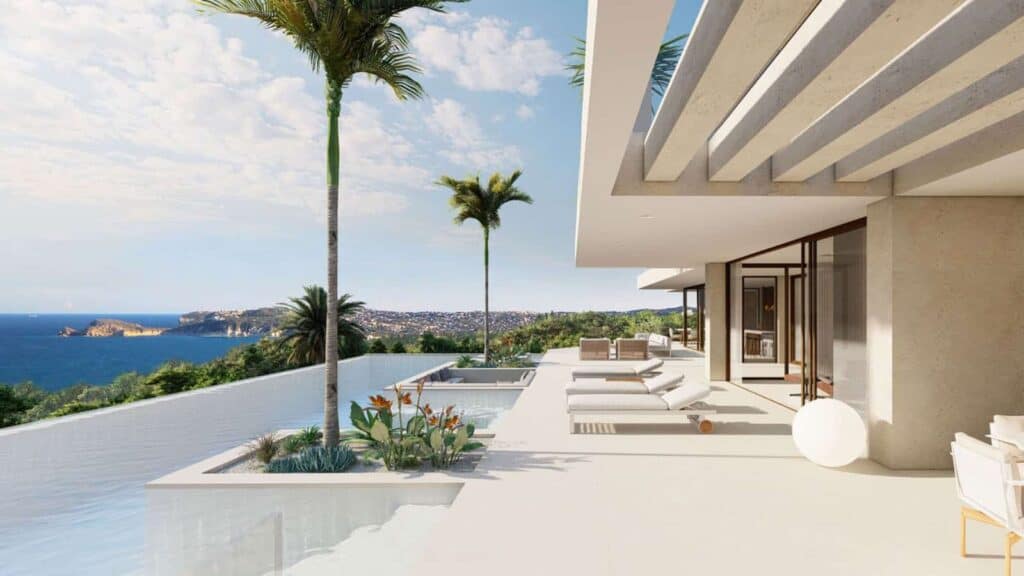
Design process of your villa
Designing a villa in Jávea involves a series of key stages that guide the entire process. From the initial consultation to the creation of detailed plans, each phase is crucial to realise the owner’s vision.
Initial consultation
The initial consultation is the first step in the design process. It is essential for the architect to understand the client’s expectations and preferences.
Definition of needs and desires
During this phase, essential elements such as the number of rooms, outdoor spaces, and any other specific requirements are identified. This dialogue allows the architect to grasp the essence of what the client desires in their new villa.
Style and functionality
The villa’s style should reflect the owner’s tastes. Functionality ensures that the spaces are practical and adapted to the desired lifestyle. Architects offer options that balance both aspects.
Creation of concepts
Once the needs are defined, preliminary concepts are created. This stage is essential for beginning to shape the initial idea with an architectural approach.
Initial sketches
The architect will produce sketches showing the first ideas of layout and style. These diagrams provide a visual framework that will facilitate later decisions.
Innovative solutions
Architectural solutions that optimise space and make the most of the natural surroundings are suggested. Creativity in this phase is key to the success of the final design.
Detailed design and plans
With the concept approved, detailed plans are created. This stage focuses on ensuring that everything complies with local regulations.
Architectural strategies
Architectural strategies will address technical and aesthetic aspects. This includes the mathematical arrangement of spaces and the selection of specific materials.
Compliance with local regulations
A successful design must adhere to current local regulations. This ensures that the construction is legal and safe, avoiding future issues.
Selection of materials and finishes
Choosing the right materials and finishes is essential for achieving a harmonious and functional design in the villa.
Natural and high-quality materials
Using natural materials such as wood and stone is a popular choice in villa design in Jávea. These materials not only add aesthetic beauty but also ensure durability. The quality of the selected materials affects the longevity of the construction.
Eco-friendly technologies
Sustainability becomes a fundamental aspect in material selection. Incorporating eco-friendly technologies helps reduce environmental impact. Some options to consider include:
- Recycled materials.
- Efficient insulation systems.
- Solar panels to harness solar energy.
Finishes in Mediterranean tones
The Mediterranean style is characterised by its neutral and warm tone finishes. These colours help create a welcoming and bright environment. Soft blues and greens are also excellent choices to reflect the natural surroundings. Proper finishes can highlight architectural elements and provide a harmonious aesthetic throughout the villa.
Construction phases
The construction phases are essential for carrying out the villa project. Each stage ensures that the established quality and design standards are met. Below are the main phases involved in the process.
Site preparation for your villa in Jávea
The first stage involves clearing and earth-moving, as well as the excavation necessary to establish strong foundations. It is essential to conduct a site analysis to ensure stability. This phase may include:
- Clearing existing vegetation.
- Earth-moving to level the ground.
- Preparation and compaction of foundations.
Construction of the main structure of your villa in Jávea
Once the site is ready, the construction of the villa’s structure proceeds. This phase is critical and requires attention to detail to ensure the durability and safety of the building.
Walls and roofs
The construction of walls and roofs defines the shape of the villa. Specific materials are used to meet local regulations, ensuring that the structure is robust and aesthetically pleasing.
Installation of windows and doors
Installing windows and doors is crucial for safety and aesthetics. These openings allow light to enter and provide views to the outside, as well as being important aspects of the overall design.
Final installations and finishes
This phase includes the integration of essential systems that optimise the villa’s functionality, as well as the details that reflect the desired style.
Electrical and plumbing systems
The installation of electrical and plumbing systems is a vital step. It ensures that everything operates efficiently and complies with current regulations.
Decoration and furnishings
Finally, the choice of decoration and furnishings further personalises the space. The aim is to create a welcoming environment that aligns with the villa’s initial concept.
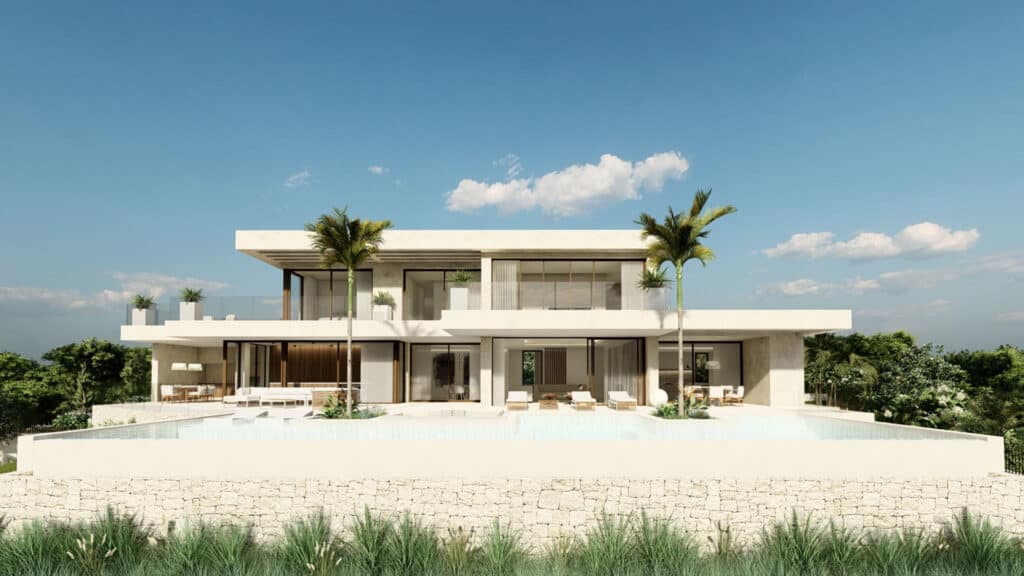
Interior and exterior design
Interior and exterior design is fundamental to creating a harmonious and comfortable environment in a villa. Each space should reflect the desired aesthetic and maximise functionality.
Interior design
Planning the interior of a villa covers various aspects that ensure comfort and style. The layout of spaces is key to promoting a natural flow and a welcoming experience.
Space layout
A good layout allows for optimal use of every square metre. It is essential to consider:
- Common and private areas.
- Connections between rooms.
- Natural and artificial lighting.
Choice of colours and textures
The selected colours and textures influence the home’s atmosphere. The palette should be cohesive, integrating:
- Neutral tones for a tranquil environment.
- Natural textures like wood and stone.
- Decorative elements that add personality.
Exterior design
The exteriors of a villa in Jávea should take advantage of the Mediterranean environment, creating spaces that invite relaxation and entertainment.
Gardens and native vegetation
Incorporating gardens with native species not only beautifies the space but also requires less maintenance. Consider:
- Drought-resistant plants.
- Spaces designed for socialising.
Pools and terraces
Pools and terraces are essential for enjoying the privileged climate. They should be designed with:
- Shaded areas.
- Convenient access from the villa.
- Decorative elements that complement the overall design.
Sustainability in construction
Sustainability has become a fundamental pillar in villa construction. Adopting eco-friendly practices not only reduces environmental impact but also improves the home’s energy efficiency.
Use of recycled materials
Incorporating recycled materials in construction is an effective strategy for minimising waste. Benefits include:
- Reduction of carbon footprint.
- Decrease in costs in some cases.
- Contribution to the circular economy.
Solar energy systems
The installation of solar panels is an increasingly popular option. This system provides clean, renewable energy that can cover part or all of the home’s energy consumption. Advantages include:
- Saving on energy bills.
- Available tax incentives.
- Energy autonomy.
Eco-friendly construction practices
These practices encompass various methodologies that prioritise energy efficiency and responsible resource use. Some of these practices include:
- Optimising design to make the most of natural light.
- Using insulation techniques to improve energy conservation.
- Implementing rainwater collection systems.
Legal considerations and permits for your villa in Jávea
Before starting the construction of a villa in Jávea, it is essential to consider the legal requirements and necessary permits to ensure that the project complies with current regulations.
Required documentation
To begin the process, several fundamental documents are required:
- Building permit: essential for any type of construction.
- Technical project: prepared by an architect detailing all design specifications.
- Environmental impact assessment: if the construction could affect the environment.
- Proof of land ownership: to demonstrate the legality of the construction on the chosen plot.
Permit acquisition process
The path to obtaining permits can be complex and requires the following steps:
- Submission of the application to the Jávea Town Hall.
- Review of the documentation by the relevant officials.
- Request for modifications if deemed necessary.
- Receipt of the building permit once all aspects are approved.
Compliance with local regulations
Each construction must adhere to municipal and urban planning regulations. These requirements are designed to protect the area’s architectural and natural heritage:
- Adherence to building height and volume regulations.
- Incorporation of sustainable and environmentally friendly elements.
- Demonstration of aesthetic compatibility with local architectural style.
Completion of construction and handover of the villa in Jávea
The completion of construction is a crucial moment in the villa building process. It is when the final touches are made and everything is prepared for the final handover.
Final adjustments and checks
Before handover, detailed adjustments are made in every area of the villa. This includes:
- Verification of electrical and plumbing systems.
- Inspection of finishes in interiors and exteriors.
- Review of storage and cabinetry to ensure functionality.
The checks also involve ensuring that all aesthetic details align with what was agreed upon in the design phases.
Cleaning and preparation
Once the necessary adjustments are made, a thorough cleaning of the villa is carried out. This process involves:
- Removal of construction waste and debris.
- Deep cleaning of floors, windows, and surfaces.
- Organisation of outdoor spaces, such as terraces and gardens.
The aim is to provide a pristine and welcoming environment for the new occupants.
Inspection and handover to the client
In the final step, a detailed inspection is conducted with the client. The work is evaluated in its entirety and it is verified that all aspects meet the agreed standards. If discrepancies arise, they are addressed immediately. After this review, the formal handover of the property to the client takes place, marking the start of a new chapter in their villa.
